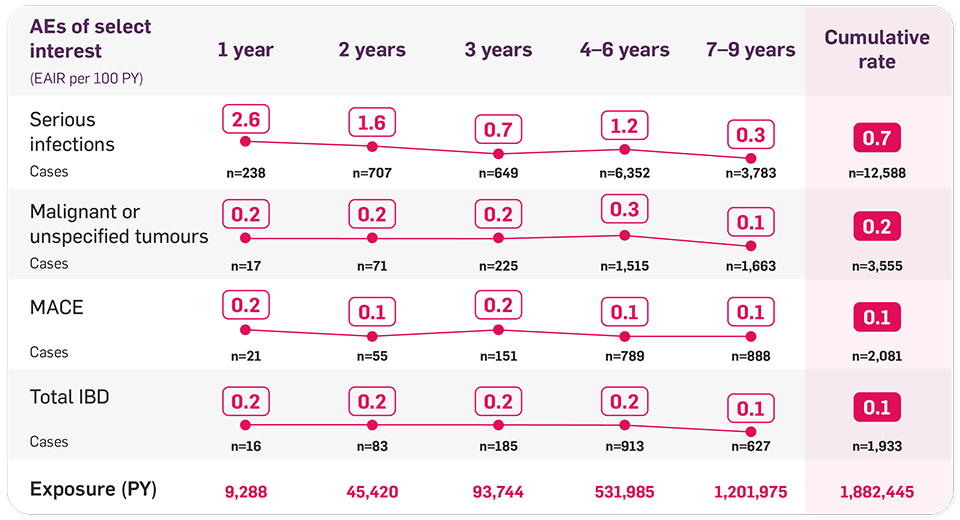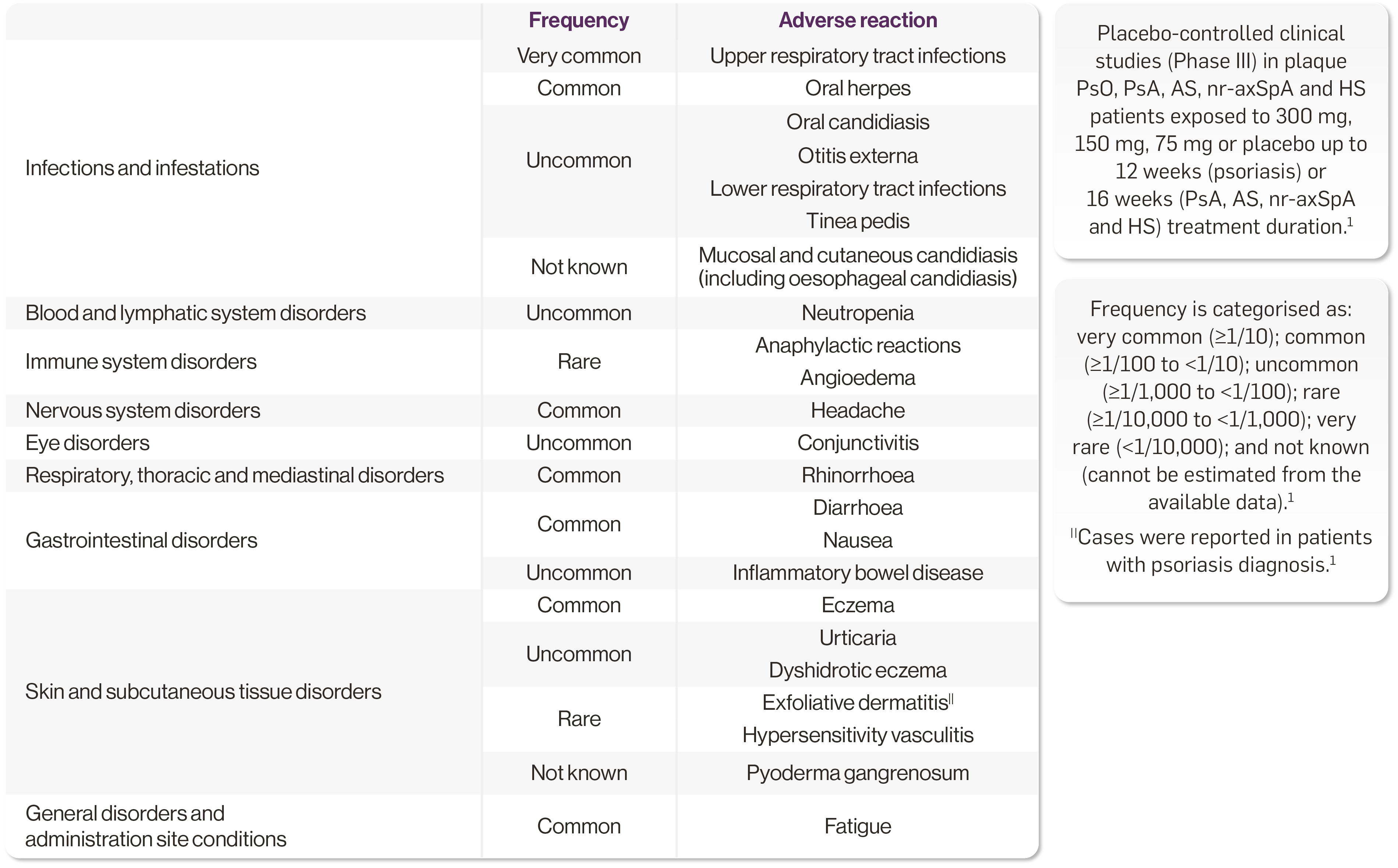Need more information?
Our dedicated team of Novartis representatives based throughout the UK are on hand to answer your local queries.
This page is intended for UK healthcare professionals and other relevant decision makers only. If you are a member of the public, please click here.
This portal is funded and owned by Novartis Pharmaceuticals UK Ltd and includes content approved by Novartis.
Adverse events reporting information can be found in the footer of this page.
Cosentyx is indicated for the treatment of moderate to severe plaque psoriasis (PsO) in adults, children and adolescents from the age of 6 years who are candidates for systemic therapy; active psoriatic arthritis (PsA) in adult patients (alone or in combination with methotrexate [MTX]) when the response to previous disease-modifying anti-rheumatic drug therapy has been inadequate; active ankylosing spondylitis (AS) in adults who have responded inadequately to conventional therapy; active non-radiographic axial spondyloarthritis (nr-axSpA) with objective signs of inflammation as indicated by elevated C-reactive protein and/or magnetic resonance imaging evidence in adults who have responded inadequately to non-steroidal anti-inflammatory drugs; active moderate to severe hidradenitis suppurativa (HS; acne inversa) in adults with an inadequate response to conventional systemic HS therapy; active enthesitis-related arthritis (ERA) in patients 6 years and older (alone or in combination with MTX) whose disease has responded inadequately to, or who cannot tolerate, conventional therapy; active juvenile psoriatic arthritis (JPsA) in patients 6 years and older (alone or in combination with MTX) whose disease has responded inadequately to, or who cannot tolerate, conventional therapy.1
Please refer to the Summary of Product Characteristics (SmPC) for further information. The UK SmPC can be found here.
*Since first indication in 2015 for eligible adults with moderate to severe plaque psoriasis.2
No discontinuations in pooled clinical trial data and real-world evidence (RWE) due to Candida infections, with all being non-serious and mild to moderate in severity, except four cases in the PsO pool that were considered severe4
No trend towards increased rates of major adverse cardiovascular event (MACE), malignancy or inflammatory bowel disease (IBD) reported over time in clinical trials or RWE5
In paediatric patients with PsO, Cosentyx demonstrated a safety profile consistent with adult indications1
The safety and efficacy of Cosentyx
in children with PsO and in JIA categories of ERA and JPsA below the age of 6 years have not been established1
No trend towards increased adverse event (AE) rates over time (pooled data; AS, PsA and PsO in a PSUR including exposure in clinical trials and marketing experience).5
Source: Novartis Data on File, 2025.5
Successive time periods of PSUR shown with cumulative rate: 26 Dec 2014 to 25 June 2015; 26 June 2015 to 25 Dec 2015; 26 Dec 2015 to 25 June 2016; 26 June 2016 to 25 Dec 2016; 26 Dec 2016 to 25 Dec 2017; 26 Dec 2017 to 25 Dec 2018; 26 Dec 2018 to 25 Dec 2019; 26 Dec 2019 to 25 Dec 2020; 26 Dec 2020 to 25 Dec 2023.5
Caution should be exercised when considering the use of Cosentyx in patients with a chronic infection or a history of recurrent infection. If a patient develops a serious infection, the patient should be closely monitored and Cosentyx should not be administered until the infection resolves.1
Patients should be evaluated for tuberculosis infection prior to initiating treatment with Cosentyx. Cosentyx should not be given to patients with active tuberculosis. In patients with latent tuberculosis, anti‑tuberculosis therapy should be considered prior to initiation of Cosentyx.1 Cosentyx is not recommended in patients with IBD. If a patient develops signs and symptoms of IBD or experiences an exacerbation of pre-existing inflammatory bowel disease, Cosentyx should be discontinued and appropriate medical management should be initiated.1
Please refer to the SmPC for full safety information before prescribing.1
The recommended dose is Cosentyx 300 mg SC with initial dosing at Weeks 0, 1, 2, 3 and 4, followed by monthly maintenance dosing.1 Based on clinical response, a maintenance dose of 300 mg every 2 weeks may provide additional benefit for patients with a body weight of 90 kg or higher.1
Treatment-emergent AEs, n (%) | Cosentyx | Cosentyx | Cosentyx |
All AEs | 127 (77.0) | 97 (72.4) | 24 (77.4) |
AEs possibly related to Cosentyx | 34 (20.6) | 29 (21.6) | 5 (16.1) |
All nonfatal SAEs | 14 (8.5) | 17 (12.7) | 4 (12.9) |
Deaths | 0 (0.0) | 1 (0.7) | 0 (0.0) |
Discontinued study treatment due to AEs | 4 (2.4) | 9 (6.7) | 2 (6.5) |
Treatment-emergent SAEs by system organ class term‡ | |||
Infections and infestations | 1 (0.6) | 6 (4.5) | 2 (6.5) |
Injury, poisoning and procedural complications | 3 (1.8) | 3 (2.2) | 1 (3.2) |
Gastrointestinal disorders | 0 (0.0) | 4 (3.0) | 1 (3.2) |
Cardiac disorders | 1 (0.6) | 3 (2.2) | 1 (3.2) |
Respiratory, thoracic and mediastinal disorders | 3 (1.8) | 1 (0.7) | 0 (0.0) |
Musculoskeletal and connective tissue disorders | 3 (1.8) | 0 (0.0) | 0 (0.0) |
General disorders and administration site conditions | 2 (1.2) | 1 (0.7) | 0 (0.0) |
Most frequent AEs by preferred term§ | |||
Nasopharyngitis | 32 (19.4) | 22 (16.4) | 5 (16.1) |
Upper respiratory tract infection | 12 (7.3) | 9 (6.7) | 3 (9.7) |
Headache | 11 (6.7) | 6 (4.5) | 1 (3.2) |
Diarrhoea | 10 (6.1) | 6 (4.5) | 2 (6.5) |
Arthralgia | 7 (4.2) | 6 (4.5) | 2 (6.5) |
Oropharyngeal pain | 3 (1.8) | 7 (5.2) | 2 (6.5) |
Cough | 7 (4.2) | 2 (1.5) | 2 (6.5) |
Back pain | 3 (1.8) | 6 (4.5) | 2 (6.5) |
AEs of special interest |
|
|
|
Infections and infestations (SOC) | 76 (46.1) | 63 (47.0) | 18 (58.1) |
Hypersensitivity (SMQ narrow) | 14 (8.5) | 6 (4.5) | 0 (0.0) |
Candida infections (HLT) | 3 (1.8) | 6 (4.5) | 1 (3.2) |
Neutropenia (NMQ narrow) | 7 (4.2) | 5 (3.7) | 3 (9.7) |
IBD (NMQ narrow) | 0 (0.0) | 0 (0.0) | 0 (0.0) |
MACE (NMQ) | 0 (0.0) | 2 (1.5) | 0 (0.0) |
Table adapted from Augustin M, et al. 2022.6
†One patient who did not receive any treatment after randomisation was excluded from the Q4W safety analyses.6
‡n≥3 in the overall study population.6
§n≥10 in the overall study population.6
In SUNSHINE and SUNRISE ≤3% of patients discontinued treatment due to any AE.7
| SUNSHINE (n=541) | SUNRISE (n=543) | ||||
Outcome (Week 16) | Cosentyx | Cosentyx | Placebo | Cosentyx | Cosentyx | Placebo |
Patients with any AEs, n (%) | 122 (67) | 118 (66) | 120 (67) | 113 (63) | 114 (63) | 116 (63) |
Most common AEs by preferred term, n (%) | ||||||
Headache | 17 (19) | 20 (11) | 14 (8) | 21 (12) | 17 (9) | 15 (8) |
Nasopharyngitis | 20 (11) | 16 (9) | 13 (7) | 13 (7) | 9 (5) | 16 (9) |
Hidradenitis | 11 (6) | 5 (3) | 24 (13) | 10 (6) | 11 (6) | 14 (8) |
Most common serious AEs by preferred term (two or more events in any group) | ||||||
Hidradenitis | 1 (1) | 0 (0) | 2 (1) | 1 (1) | 0 (0) | 0 (0) |
Patients with serious or other significant events, n (%) | ||||||
Deaths | 0 | 0 | 0 | 0 | 0 | 0 |
Non-fatal SAEs | 3 (2) | 3 (2) | 6 (3) | 6 (3) | 6 (3) | 5 (3) |
Discontinued study | 5 (3) | 1 (1) | 1 (1) | 1 (1) | 4 (2) | 4 (2) |
AEs of special interest, n (%) | ||||||
Infections and infestations | 59 (33) | 51 (28) | 53 (29) | 52 (29) | 59 (33) | 62 (34) |
URTI | 33 (18) | 26 (14) | 22 (12) | 27 (15) | 21 (12) | 29 (16) |
Fungal infectious disorders | 12 (7) | 1 (1) | 7 (4) | 7 (4) | 13 (7) | 3 (2) |
Candida infections | 2 (1) | 1 (1) | 4 (2) | 5 (3) | 5 (3) | 2 (1) |
Hypersensitivity | 12 (7) | 9 (5) | 9 (5) | 7 (4) | 5 (3) | 7 (4) |
IBD¶ | 0 (0) | 0 (0) | 0 (0) | 1 (1) | 1 (1) | 0 (0) |
Malignant or unspecified tumours | 0 (0) | 0 (0) | 1 (1) | 0 (0) | 2 (1) | 1 (1) |
MACE | 0 (0) | 0 (0) | 0 (0) | 0 (0) | 0 (0) | 0 (0) |
Adapted from Kimball AB, et al. 2023.7
¶One case of IBD and one case of ulcerative colitis were reported.6
Cases of IBD have been reported with Cosentyx; therefore, it is not recommended in patients with IBD. Please refer to the SmPC for full safety information.1
The most frequently reported AEs were upper respiratory tract infections (17.1%; most frequently nasopharyngitis, rhinitis). The safety profile is consistent across indications.1
Adapted from Cosentyx SmPC.1
Please refer to the SmPC for full prescribing information and safety profile.1
Please refer to the SmPC for detailed safety profile data and full prescribing and administration information, including dosing in special populations and warnings/precautions.1
Cosentyx is intended for use under the guidance and supervision of a physician experienced in the diagnosis and treatment of conditions for which Cosentyx is indicated. Please refer to the Cosentyx SmPC for full product information before prescribing.1
Augustin et al: Multicentre, double-blind, parallel-group trial (N=331) in adult patients with moderate to severe PsO weighing ≥90 kg, randomised to receive Cosentyx 300 mg Q2W or Q4W. The primary endpoint was PASI 90 response at Week 16. Secondary endpoints included the proportion of patients achieving an IGA mod 2011 score of 0 or 1 (indicating clear or almost clear skin) at Week 16, and clinical safety and tolerability measures (clinical laboratory parameters, vital signs, electrocardiograms and AEs) up to Week 52. At Week 16, Q2W dosing (n=165) led to significantly higher PASI 90 responses vs Q4W (n=166) with 73.2% vs 55.5%, respectively (OR: 2.3; 95% CI: 1.4–3.8; p=0.0003).6
SUNSHINE and SUNRISE: Identical, multicentre, randomised, placebo-controlled, double-blind Phase III trials. They were conducted in 219 primary sites in 40 countries. Patients (SUNSHINE N=541; SUNRISE N=543) were randomised to receive 300 mg Cosentyx Q2W, Cosentyx 300 mg Q4W group or placebo in a double-dummy fashion as per treatment assignment. Efficacy assessments included HS clinical response, abscess and inflammatory nodule count, flares and skin pain. The primary objective of both trials was clinical efficacy at Week 16. Secondary endpoints included mean percentage change from baseline in abscess and inflammatory nodule count at Week 16, the proportion of patients with flares over 16 weeks and the proportion of patients at Week 16 with a 30% or more reduction and reduction of two units or more of skin pain on a continuous numeric rating scale (NRS30) (assessed in patients with a baseline numeric rating of three or more). For both groups, the primary endpoint was met in the Cosentyx Q2W group. In SUNRISE, the Q4W also met the primary endpoints. In SUNSHINE, the primary endpoint was not met in the Cosentyx Q4W group.7
Therapeutic indications1
Cosentyx is indicated for the treatment of moderate to severe PsO in adults, children and adolescents from the age of 6 years who are candidates for systemic therapy; active PsA in adult patients (alone or in combination with MTX) when the response to previous disease-modifying anti-rheumatic drug therapy has been inadequate; active AS in adults who have responded inadequately to conventional therapy; active nr-axSpA with objective signs of inflammation as indicated by elevated C-reactive protein and/or magnetic resonance imaging evidence in adults who have responded inadequately to non-steroidal anti-inflammatory drugs; active moderate to severe HS (acne inversa) in adults with an inadequate response to conventional systemic HS therapy; active ERA in patients 6 years and older (alone or in combination with MTX) whose disease has responded inadequately to, or who cannot tolerate, conventional therapy; active JPsA in patients 6 years and older (alone or in combination with MTX) whose disease has responded inadequately to, or who cannot tolerate, conventional therapy.1
AE, adverse event; AS, ankylosing spondylitis; EAIR, exposure-adjusted incidence rate; ERA, enthesitis-related arthritis; HBV, hepatitis B virus; HLT, high-level term; HS, hidradenitis suppurativa; IBD, inflammatory bowel disease; IGA, investigator global assessment; JPsA, juvenile psoriatic arthritis; MACE, major adverse cardiovascular event; MTX, methotrexate; nr-axSpA, non-radiographic axial spondyloarthritis; NRS30, numeric rating scale 30; NMQ, Novartis MedDRA query; PASI, psoriasis area and severity index; PsA, psoriatic arthritis; PsO, plaque psoriasis; Q2W, every 2 weeks; Q4W, every 4 weeks; RWE, real-world evidence; SAE, serious adverse event; SmPC, summary of product characteristics; SMQ, standardised MedDRA queries; SOC, standard of care; URTI, upper respiratory tract infection.
References
Cosentyx® (secukinumab) Summary of Product Characteristics.
European Medicines Agency. Summary of positive opinion EMA/CHMP/670/0627/2015. Available at: https://www.ema.europa.eu/en/documents/smop/chmp-post-authorisation-summary-positive-opinion-cosentyx_en.pdf [Accessed August 2025].
Novartis Data on File. Secukinumab (SEC018). February 2025.
Deodhar A, et al. Arthritis Res Ther 2019;21(1):111.
Novartis Data on File. Secukinumab (SEC020). April 2025.
Augustin M, et al. Br J Dermatol 2022;186(6):942–954.
Kimball AB, et al. Lancet 2023;401(10378):747–761
UK | August 2025 | FA-11328326-2
Adverse events should be reported. Reporting forms and information can be found at www.mhra.gov.uk/yellowcard. Adverse events should also be reported to Novartis online through the pharmacovigilance intake (PVI) tool at www.novartis.com/report, or alternatively email [email protected] or call 01276 698370.






